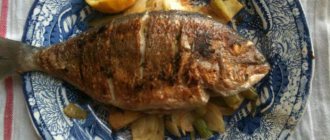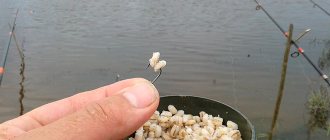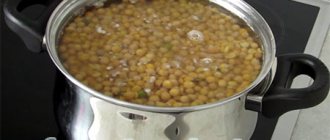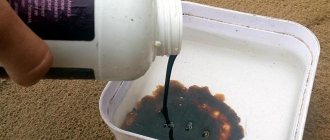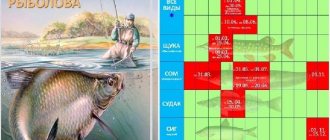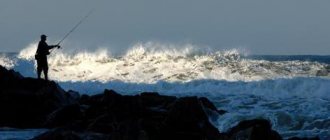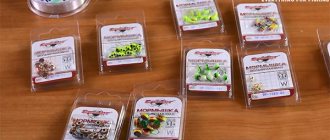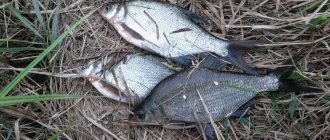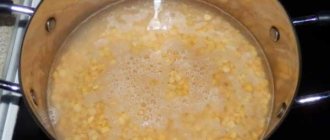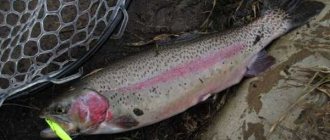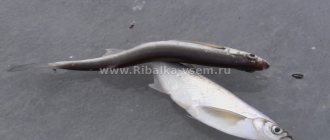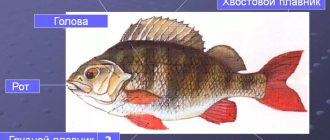Hot pea crumpet
Take half a glass of unpeeled peas, pour it into an iron bowl and pour in a little less than a glass of warm water, after which the peas should sit for a while and absorb the liquid. After the peas have swollen and partially absorbed the water, add warm water to such a level that it covers the peas, and then begin to cook over low heat (immediately after boiling). The pulp should be cooked for two hours, constantly stirring the contents, while trying to avoid burning, since fish does not like the smell of burning.
Bring the resulting mixture to a mushy mass, then add a tablespoon of sugar and two pinches of vanillin. While stirring the resulting mixture, add semolina (until the paste thickens). As soon as the resulting mixture reaches the state of kneaded dough, remove it from the stove and grind it in a meat grinder to crush large lumps.
After this, the hot-cooked pea crumpet is ready. It is convenient to roll it into balls, the bait stays well on the hook, and the aroma attracts hungry fish.
Complementary foods can be stored in the freezer.
How to cook split peas?
In the second cooking option, we use shelled peas from the store. Fill the peas with water and let it brew for 4-6 hours. After this, add 1-2 tablespoons of sugar, a pinch of salt and, if desired, a couple of cloves of garlic (it works especially well for attracting crucian carp at any time of the year).
Place the prepared peas on the fire and cook for 20-25 minutes, until the peas become soft. When cooking, you need to be careful to ensure that the peas do not burn. It has been observed that the smell of burnt peas can significantly reduce the attractiveness of the mixture.
After cooking, drain the water from the peas and place them on a baking sheet. At the same time, it will cool and dry out. After the peas have dried, grind them in a meat grinder or blender. The resulting mixture is quite crumbly and, when squeezed, has the required density. These peas can be used in a feeder on their own. It will create a strong pea trail while still providing good nutritional properties to hold fish.
This vegetable will be an indispensable bait for all varieties of carp.
Cold cooked pea crumpet
For cold-cooked pea crumpet we need pea flour, raw chicken egg and wheat flour.
Pour a chicken egg into three tablespoons of pea flour and carefully mix the resulting mixture until smooth. Add wheat flour to the resulting mixture and knead the complementary foods until it forms a dough that does not stick to your hands. The cold brew mixture is ready.
If you don’t have pea flour, and the nearest stores have a small selection, then you can make the flour with your own hands. Pea grains can be ground in a coffee grinder or grain mill, after which the resulting cereal is crushed with a mortar or blender and passed through a sieve.
Cooking methods
Due to the variety of ingredients, you can make dough for crucian carp fishing using several good recipes.
Classic recipe
To give the finished bait an aroma that attracts fish, add a little vegetable oil.
The classic dough for catching crucian carp and other peaceful fish species is prepared according to the following recipe:
- Pour 250 milliliters of cold water into a small container;
- Add one egg yolk and a few tablespoons of flour to the water;
- The contents of the container are thoroughly mixed with a whisk until a homogeneous elastic mass is obtained;
- The raw dough is placed on a table sprinkled with flour and kneaded until it stops sticking to your hands.
Recipe with flour and semolina
According to this recipe, this nozzle is prepared as follows:
- Semolina and flour are mixed dry in a ratio of 1:1.5;
- While constantly stirring the resulting dry mixture, add water in small portions until a dough-like dense substance is formed;
The readiness of the nozzle is determined by periodically kneading it with your fingers. The finished dough does not stick to your hands and rolls well into balls. If the bait sticks to your fingers and stretches, add a little flour and knead thoroughly again.
Corn flour dough with egg yolk
A flavoring is added to the finished attachment - honey or a little garlic crushed into a paste.
A catch bait made from cornmeal and egg yolk is prepared as follows:
- Corn flour is sifted through a sieve with a mesh size of 1.5-2 mm;
- The sifted flour is poured into a pan and filled with water in a ratio of 5:4;
- Cook the mixture in a saucepan over low heat for 10 minutes after the water boils in it;
- Add one tablespoon of honey and an egg yolk to the porridge formed during cooking;
- After the contents of the pan have cooled to room temperature, knead it with your hands until it stops sticking to your fingers.
A flavoring is added to the finished attachment - honey or a little garlic crushed into a paste.
Potato dough
The following ingredients are used for preparation:
- 150 g wheat flour;
- 2 small cloves of garlic;
- Two medium-sized boiled potatoes;
- Egg yolk;
- water.
All components are passed through a meat grinder twice. Add a little oil to the resulting mixture and mix well until done.
Pea dough
Flavorings or unrefined sunflower oil are added to the finished attachment.
The attachment for this recipe is as follows:
- Peas are soaked for 4-5 hours. In this case, water is poured in such a way that it completely covers the grains placed in it;
- The swollen grains are boiled in a small amount of water until porridge forms. To do this, they are placed in a large saucepan with a lid or a pressure cooker.
- Wheat flour or semolina is added to the resulting mass until a stiff dough is formed;
- Place the dough on a table generously sprinkled with flour and knead thoroughly until it stops sticking to your hands and the table.
Fishing on the Don
Tackle, equipment and equipment. Testing something new, describing what has been tried.
Recipes for my most catchy crumpets (for crucian carp, carp, bream, roach, vimba, podusta, etc.):
1. “Hot” prepared pea crumpet (troublesome and almost never used, home-made): Pour half a glass of unshelled peas into a saucepan and pour warm water so that it absorbs some of the water and swells. As soon as the water is absorbed, you need to add just enough water to cover the peas. Then put it on the fire, let it boil and immediately reduce the heat to low - cook for two hours, stirring, so as not to burn (the smell of burnt will definitely scare away the fish). At the end of cooking, the peas look like a monotonous, squishing and steaming mass. While it is hot, you need to add a tablespoon of sugar and some vanillin crystals. While stirring, add semolina to it until it turns into a lump that does not stick to your hands. You can pass the crumpet through a meat grinder so that there are no lumps. If everything is done correctly, the crumpet will not dry out, will roll into balls well, stay firmly on the hook and will smell delicious. If you fish with one float rod, then as a rule there is less crumpet for the day of fishing than prepared. Therefore, it is better to divide the cooked and cooled donut into portions, pack them in different plastic bags and put them in the freezer of the refrigerator. It is recommended to do the same with crumpets obtained according to the recipes described below. It is enough to place the frozen crumpet in the cooling chamber of the refrigerator the evening before morning fishing and it will be ready for morning fishing. And for fishing, which takes several hours to get to, you can take frozen crumpet; this way it will better retain its properties. When stored for a long time in a plastic bag at positive ambient temperatures, donuts tend to become moldy, which is not to the fish’s taste at all! 2. “Cold” pea crumpet: Mix three tablespoons of pea flour with the contents of a fresh raw chicken egg. Add wheat flour to the resulting sticky mass, kneading it into the dough until you get a dough ball, the balls of which will not stick to your hands and at the same time will stick well to the hook. The difficulty in making crumpet is where to get the pea flour. The mixer does not pick up peas because they are hard. A coffee grinder or grain mill helps. In this case, the peas are ground at best into cereal. And, in order to extract flour from cereals, it is enough to sift the cereals on a fine-mesh sieve. It is better to prepare pea flour for future use. I always have a jar of this kind of flour lying around in my car, from which I can quickly mix mash with river water if necessary. 3. Cold-cooked cake donut: The donut is made in the same way as in the previous recipe. Only instead of pea flour we use flour, which is easier to buy ready-made at a fishing store.
Bait recipe for moderate currents (works on all carp): In the evening we prepare two strong new plastic bags. We insert one package into another. In such a two-layer “thermos” we pour 1/3 of a kilogram bag of “Hercules” oatmeal and a two hundred gram glass of “faceted” makukha. Twist the bag and mix the mixture dry. Then carefully pour 0.4-0.6 liters of boiling water (steep boiling water) into the bag with the mixture. Just in case, it is better to perform this procedure over a sink and remember that hot steam can scald not only your hands, but also your stomach, and even your penis, if your stomach does not protect it from above. Then, leaving air in the bag of porridge, tie a loop knot around the neck (of the bag) and, using a towel, knead the porridge in the bag. At night, wrap the bag in the same towel and leave it until the morning. In the morning, “on a cold day,” you can knead the porridge, and when fishing, make a hole in a double bag and pour out the required amount of viscous porridge to make balls. The balls of such porridge should turn out viscous, creating a turbidity that attracts fish immediately after sinking to the bottom. With some training, such preparation of bait does not cause any trouble. And most importantly, you don’t need to wash or throw away the pan after porridge!
Preparing mastyrka for catching crucian carp
Catching crucian carp with a float rod has long been a favorite pastime of many fans of traditional Russian fishing. And although the tackles themselves, the baits, and the methods of fishing have changed a lot, this pastime, familiar from childhood and still a favorite, leaves few people indifferent.
In this article I will not go into detail about the use of ultra-modern gear for catching carp fish. All the same, in essence the methods remain the same: fishing with a float, fishing with a donk (a hook or an elastic band). And the most important component of successful fishing for crucian carp, carp, and carp is always a well-prepared and selected bait-bait.
A little about the carp itself. The fish of the carp family is quite thermophilic, hardy and very tenacious. It easily adapts to almost any conditions, even to partially dry wetlands of several tens of square meters in area. Crucian carp only dislikes cold water and strong currents. There are two forms of this fish - golden and silver crucian carp. The diet of crucian carp is very varied and the bait for catching it can be either animal bait (worms, larvae, maggots, shells), especially in spring and autumn, or bait of plant origin (various cereals, potatoes, etc.) - they are suitable for fishing in summer, when the water warms up. Among the vegetable baits that I use for fishing on Akhtuba in the summer, the most catchy and convenient is the so-called mastyrka - a custard dense mass based on peas with additives. Simple in essence, it is, however, not so easy to make, especially since improperly prepared mastyrka is more likely to scare away the crucian carp and you can give up on fishing.
So, how to properly prepare mastyrka for crucian carp?
I want to warn you right away that at first you will have to “suffer a little”, getting your hands on in this process, since a clear recipe will not work here.
only because all the components will have slightly different properties each time, and the result should always be the same: a dense, rubbery mass that does not stick to your fingers with an appetizing smell (after all, it’s no secret that crucian carp, like carp, like the taste and smell reminiscent of human plant food). But if you have enough patience and everything works out, you are guaranteed a good bite and crucian carp fried in sour cream for dinner.
As already mentioned, the basis of mastyrka is peas. You can use regular yellow or green dried peas from the store. If you have time, 2 mills of peas should be soaked in cold water to swell for several hours. Next, pour fresh water over the peas two fingers above the grains and cook a thick porridge over low heat. Be sure to stir constantly so it doesn't burn! – otherwise you’ll have to start all over again.
As soon as the porridge is ready, rub up to 3 cups of semolina into it until it has a homogeneous consistency and knead until the mass stops sticking to your hands. You can also add a little flour (wheat, corn, rye) - this will give the mass additional strength and aroma, as well as a tablespoon of hemp or sunflower (unrefined) oil - the oil will make the future bait more “waterproof” and will attract fish with its smell.
Roll the finished mixture into a ball and place in a saucepan in the refrigerator. The next day you should get a dense mass that rolls well into a ball, does not get soggy on the hook and smells “divine.”
The experimental part of preparing mastyrka and practical advice.
Above was a description of the “classical” method of preparing mastyrka, the “basic” basis, so to speak. And now about the experiments. I,
To be honest, I am not a supporter of the use of modern fishing chemicals, such as flavoring additives, dyes and various attractants (substances that attract fish), since I think that the natural smells and colors of fishing baits are preferable and I make do with the addition of vanillin, anise, buckwheat honey, raw eggs, sugar. You can use corn sticks, halva, fresh makukha (pressed sunflower cake) and even garlic.
As for useful tips for preparing mastyrka, they will primarily help save time.
- You can speed up the process by using a pressure cooker. The preparation time for the pea base is reduced to 20-25 minutes, but you need to carefully select the ratio of water and grains experimentally, otherwise the porridge will either burn or turn out liquid.
— instead of whole peas, you can use ground peas in a coffee grinder, thereby eliminating the soaking process and speeding up cooking.
- you can add a little baking soda when cooking whole peas - the mastyrka will cook faster, but this will affect its color and taste, and the crucian carp may not like the bait. Storage and use of mastyrka
It is better to store fishing mastyrka in the refrigerator directly in the pan, and take it with you wrapped in a clean cotton napkin. Under no circumstances should you freeze it - it becomes crumbly and loses its stickiness. It is also not advisable to store it in polyethylene - the mass begins to sweat and change its properties.
The weathered upper crust of the mastyrka coma, as well as the failed one (only not burnt), can be used to add to the base bait or as the main bait - for example, to fill the feeder of the feeder tackle.
You can make balls in advance and put them in a small glass container, greased with vegetable oil, but I usually roll the balls for bait right in the process of catching crucian carp - this way it’s easier to choose the size depending on the hook and the bait will be fresher.
By the way, when fishing for crucian carp on Akhtuba in Three Rivers, I often catch decent bream using mastyrka, as well as carp and tench, especially if a raw egg or lean cottage cheese is added to the mastyrka. Of course, there are days when the fish refuses to take this bait, but this does not happen often and, besides, I always take at least a few worms with me. And I almost always do mastyrka, especially in the summer.
Happy fishing!
More
Peas for fishing. A simple recipe for making a thick bait
After some fishermen prepared hominy according to the recipe from our website, many questions arose about how to cook peas. Simply boiled pea porridge is not very suitable for attachment, and you don’t always want to “tinker” with pea porridge (a mixture based on peas). So why not try taking pea flour, mixing it with wheat flour and boiling this mixture in bags? But not everything is as simple as it turned out.
I had to choose my own proportion and cooking time. Over the past season, this mixture was tested on rivers more than once. As expected, the bream appreciated it well. There are reservoirs where peas are almost the best bait for white fish, and for such conditions we offer two cooking options.
First, we present our video “How to cook peas for fishing?”
Now a little theory.
Option-1 In our opinion, the most accessible and simplest method. First you need to cook regular pea porridge. For this purpose, take yellow peas, pour in twice as much water as the cereal, and cook for about an hour until all the grains are boiled. After cooking, drain off excess water (if any). So, we need:
Mix porridge and wheat flour in a ratio of 2 to 1 (by weight). The finished mixture in this proportion will be of medium density. If you need to increase the density, then make a ratio of 1 to 1. Add water, mix, achieving the consistency of thick sour cream. You can also add your favorite aromatics at this stage.
Pour the mixture into a bag. It is better to use two bags to prevent leaks during cooking.
Option-2 We will need:
Mix pea and wheat flour 1k1. With a lower concentration of wheat flour, the mixture will crumble; with a higher concentration, we obtain the necessary density and stickiness, but lose the smell of peas (the result is a regular “dough” with a slight pea aroma).
We get such a nozzle. It is darker (understandable, because not only yellow grains will be used for flour) and less sticky, more suitable for smooth casting.
Conclusions So, we looked at two options for cooking peas. The first one (with porridge) is more affordable and makes it possible to get a good (strong) bait. You can buy peas for porridge anywhere and cook them, no big problem. The second option gives a slightly worse result and also requires pea flour, which you can’t buy everywhere. We looked for it for a long time, such flour is very rarely found in stores, we only found it at the market. And its price is also not small, so we use pea porridge and are happy.
Share your ways of cooking peas in the comments. Try ours, write your comments and suggestions. For example, as an option, you can also mix the crumb of white bread and ready-made pea porridge in a blender, adding water until the required consistency is obtained. So there are many recipes, the main thing is to choose one that is easy and catchy. Health and Joy to everyone!
Bait recipes
If you are going fishing to a pond where crucian carp lives, then without good complementary food you are unlikely to be able to catch anything. Therefore, it is necessary to prepare in advance and cook the right complementary foods. The main thing here is that the porridge is very aromatic and noticeable to fish living at the bottom of reservoirs.
Recipe 1
Anglers very often use mastyrka as complementary food. This is a special porridge that requires a certain amount of ingredients, including peas. Moreover, each fisherman may have his own cooking recipe and differ from another. It all depends on the reservoir where the fish are caught, what kind of fish lives there, and what they were fed with before.
Let's consider one of these simple bait recipes.
So, you will need:
- peas;
- semolina;
- pearl barley;
- corn;
- wheat;
- flavorings – vanilla, hemp and others.
Procedure:
- Take the peas and wash them thoroughly. Fill it with water and leave it for 10-15 hours.
- After the time has passed, drain the water. Pour the soaked peas into a saucepan and add water in a ratio of 1 to 2.
- Initially, it is advisable to take ground peas or halves, because after cooking, whole peas will have to be ground.
- Place the pan on the stove, bring the water to a boil, reduce the heat and cook, stirring occasionally with a spoon.
- As soon as the complementary foods resemble liquid pea porridge, you need to add the following ingredients: pre-boiled pearl barley, boiled corn, preferably young, pre-soaked wheat.
- Mix dry semolina with vanilla from a bag, hemp or other flavoring of your choice.
- After all the ingredients have been added, mix everything and wait for it to boil.
- After boiling, add semolina mixed with flavorings.
- You need to add semolina until you get a very thick consistency. And don't forget to stir all the time. The mixture should be such that it becomes very difficult to mix.
- Once the porridge becomes very viscous, remove the pan from the heat and leave it until it cools completely.
- Once the mastyrka has completely cooled, you can roll it into balls of the required size.
When preparing complementary foods, do not forget to stir them constantly. The finished mastyrka balls should be of such a size that they can dissolve in water for a long time, spreading the aroma and all the particles of the components.
Recipe 2
For this recipe you will need:
- Peas. Yellow is the best color here.
- Wheat flour.
- Balls from bags.
- Threads.
Procedure:
- You need to cook porridge from washed yellow peas. To do this, take water and peas in a ratio of 2 to 1.
- Pea porridge should be cooked for at least an hour. It is necessary that all the peas are completely boiled.
- If there is any water left after cooking, it must be drained.
- Now add flour to the pea porridge in a ratio of 2 to 1. If the consistency is not very dense, then you can add more flour and mix everything thoroughly.
- Then you can add flavorings. Which ones you need will depend on the taste preferences of your future catch.
- Add water in such an amount that your complementary foods are as thick as sour cream with a high fat content.
- Now put the finished mixture into a bag. To be safe, you can use 2 at once. Tie the bag tightly and place it in a pan with cold water. The bait needs to cook for about 30 minutes.
- 20-30 minutes after the water boils, turn off the fire and leave the bag of pea food to sit for a while in the same container of water.
As a result, you will get a dense pea porridge, which can be cut into small pieces and used as bait on a hook and bait for fish. Also, the bait in this form can be used together with a feeder.
Recipe 3
You will need:
- pea flour;
- wheat flour;
- small plastic bags;
- threads
Procedure:
- Mix pea and wheat flour. For this recipe you need to use both flours in equal proportions.
- At this stage you can add the necessary flavorings.
- Now we add water and bring the consistency of the complementary food to a state where it is not too thick, as in the previous version, but does not flow off the spoon.
- Place the prepared mixture into bags and tie them tightly with thread.
- Place in a saucepan with cold water and cook for 30 minutes.
All other steps will be similar to the previous recipe. In this option, only the procedure is changed; with it, of course, the entire cooking process is significantly shortened.
Recipe 4
The bait prepared according to this recipe is perfect for fishing for silver carp.
You will need:
- peas;
- baking soda;
- semolina;
- honey.
Procedure:
- Take a large saucepan and pour at least 4 liters of water into it. Place it on the stove and wait until the water gets very hot.”
- Without waiting for it to boil, pour 1 kg of washed peas into the water.
- As soon as the peas begin to boil, you will need to add 2 tbsp. l. baking soda. At the same time, do not forget that the peas must be thoroughly mixed both before and after boiling.
- Pea porridge should be cooked over low heat for at least 3 hours. All peas must be thoroughly boiled.
- After the desired consistency is obtained, the pan must be removed from the stove. Next you need to drain the pea broth. To do this, place the colander on another convenient container. Whatever remains in the colander will no longer be useful. But what is poured into the container during the process will need to be used further.
- The container with the broth must be placed on the stove and brought to a boil.
- Now, while it is boiling, add semolina gradually and in small portions to this liquid. You will need about 2 kg.
- When you add semolina, do not forget to constantly stir everything so that there are no lumps. The result should be a porridge that will be difficult to stir.
- The semolina should swell completely and the porridge should thicken. As soon as the porridge starts to boil, remove the pan from the stove.
- The container with the pan can be immediately removed onto a wooden cutting board.
- As soon as you remove the porridge from the stove, semolina must be continuously added and mixed. Add semolina until it is no longer possible to mix with a spoon.
- Place the resulting porridge on the board. Sprinkle the board with semolina first.
- Mix the porridge with semolina. Stir until the food stops sticking to your hands. In this case, the mass should not be cold and should cool down after you have mixed everything.
- Take 1 tbsp. l. honey and melt in a water bath.
- Pea feeding should be divided into several small parts and honey should be added to each of them and everything should be mixed thoroughly again.
Ready-made bait will be useful to you not only on your upcoming fishing trip.
This amount of porridge will be enough for several more trips. Therefore, such a preparation can be put into bags and frozen for a long time.
Bait is extremely important!
In fact, complementary feeding plays one of the most important roles when fishing. After all, with its help, the fisherman creates the best conditions for biting and catching exactly the type of fish he came for. Good complementary feeding can increase the bite several times; in addition, the fish become less cautious, since by feeding the fishing area, the angler accustoms the fish to his bait.
Avid carp fishermen know very well that there is no universal remedy for uninterrupted carp bites, because... these fish are quite picky and often change their gastronomic preferences. In such a situation, only the fisherman’s many years of experience and his intuition help out, with the help of which the fisherman is able to select effectively working baits.
Before starting to prepare the bait mixture, the fisherman must carefully and thoughtfully study the places of future fishing. For successful fishing, it is important to know what factors can affect the ingredients of complementary food, types and its density.
These are the factors:
- water temperature;
- current strength;
- water clarity;
- underwater thickets in the fishing area.
If you plan to catch carp at shallow depths and insignificant currents, then you need to add additional ballast to the complementary food - soil, ideally dry. When preparing complementary foods, it is also important not to overdo it with water. Therefore, you need to add water in small portions, mixing thoroughly each time. The bait for such fishing areas should be a little rough.
If there is no current at all in the fishing area, then complementary feeding should be even denser.
If fishing is to be done in a stagnant body of water or in a quiet backwater, then coastal sand should be added to the mixture in a ratio of 5 to 1 of the total volume.
In accordance with the seasons of the year, flavorings are added to complementary food for carp fishing:
- In the warm season - summer and spring, carp like the aromas of cinnamon and anise oil; you can also add berry and fruit smells to complementary foods. Fish responds well to apple, banana and pear flavorings;
- In winter, carp react more readily to corn with meat aromas.
In summer and winter, you should not overdo it with complementary foods, and in the fall or spring (since carp have a period of gluttony), you can throw in more complementary foods. In any case, the fisherman’s task is only to attract fish, and not to saturate it.
Well, now the recipes for especially catchy crumpets for catching carp and fish of the carp family.
Hot pea crumpet
Half a glass of unpeeled peas should be poured into an iron bowl and filled with a glass of warm water. The peas need to be left for a while so that they have time to absorb water. When the peas swell, partially absorbing water, you need to add enough water so that all the peas are in the water. Let's cook it. As soon as it boils, reduce the heat to minimum. The peas need to be cooked for two hours, stirring regularly, and making sure that they do not burn, otherwise everything will have to be redone. Fish react extremely negatively to the smell of burnt food.
The mixture should have a mushy consistency. At the end of cooking, add a tablespoon of sugar and a couple of pinches of vanillin to the peas. If the porridge is not thick enough, you can add semolina to it. As soon as the mixture has acquired the consistency of kneaded dough, the hot-cooked pea crumpet is ready.
It rolls into balls without any problems, stays on the hook perfectly, and its smell attracts hungry carp.
This crumpet is stored in the freezer, after melting, it retains its properties.
Bait is extremely important!
In fact, complementary feeding plays one of the most important roles when fishing. After all, with its help, the fisherman creates the best conditions for biting and catching exactly the type of fish he came for. Good complementary feeding can increase the bite several times; in addition, the fish become less cautious, since by feeding the fishing area, the angler accustoms the fish to his bait.
Avid carp fishermen know very well that there is no universal remedy for uninterrupted carp bites, because... these fish are quite picky and often change their gastronomic preferences. In such a situation, only the fisherman’s many years of experience and his intuition help out, with the help of which the fisherman is able to select effectively working baits.
When preparing complementary foods, the fisherman must take into account the characteristics of the reservoir, weather and other factors.
Before starting to prepare the bait mixture, the fisherman must carefully and thoughtfully study the places of future fishing. For successful fishing, it is important to know what factors can affect the ingredients of complementary food, types and its density.
These are the factors:
- water temperature;
- current strength;
- water clarity;
- underwater thickets in the fishing area.
If you plan to catch carp at shallow depths and insignificant currents, then you need to add additional ballast to the complementary food - soil, ideally dry. When preparing complementary foods, it is also important not to overdo it with water. Therefore, you need to add water in small portions, mixing thoroughly each time. The bait for such fishing areas should be a little rough.
If there is no current at all in the fishing area, then complementary feeding should be even denser.
If fishing is to be done in a stagnant body of water or in a quiet backwater, then coastal sand should be added to the mixture in a ratio of 5 to 1 of the total volume.
In accordance with the seasons of the year, flavorings are added to complementary food for carp fishing:
- In the warm season - summer and spring, carp like the aromas of cinnamon and anise oil; you can also add berry and fruit smells to complementary foods. Fish responds well to apple, banana and pear flavorings;
- In winter, carp react more readily to corn with meat aromas.
In summer and winter, you should not overdo it with complementary foods, and in the fall or spring (since carp have a period of gluttony), you can throw in more complementary foods. In any case, the fisherman’s task is only to attract fish, and not to saturate it.
Well, now the recipes for especially catchy crumpets for catching carp and fish of the carp family.
Pea crumpets work great when fishing for carp
Hot pea crumpet
Half a glass of unpeeled peas should be poured into an iron bowl and filled with a glass of warm water. The peas need to be left for a while so that they have time to absorb water. When the peas swell, partially absorbing water, you need to add enough water so that all the peas are in the water. Let's cook it. As soon as it boils, reduce the heat to minimum. The peas need to be cooked for two hours, stirring regularly, and making sure that they do not burn, otherwise everything will have to be redone. Fish react extremely negatively to the smell of burnt food.
The mixture should have a mushy consistency. At the end of cooking, add a tablespoon of sugar and a couple of pinches of vanillin to the peas. If the porridge is not thick enough, you can add semolina to it. As soon as the mixture has acquired the consistency of kneaded dough, the hot-cooked pea crumpet is ready.
It rolls into balls without any problems, stays on the hook perfectly, and its smell attracts hungry carp.
This crumpet is stored in the freezer, after melting, it retains its properties.
